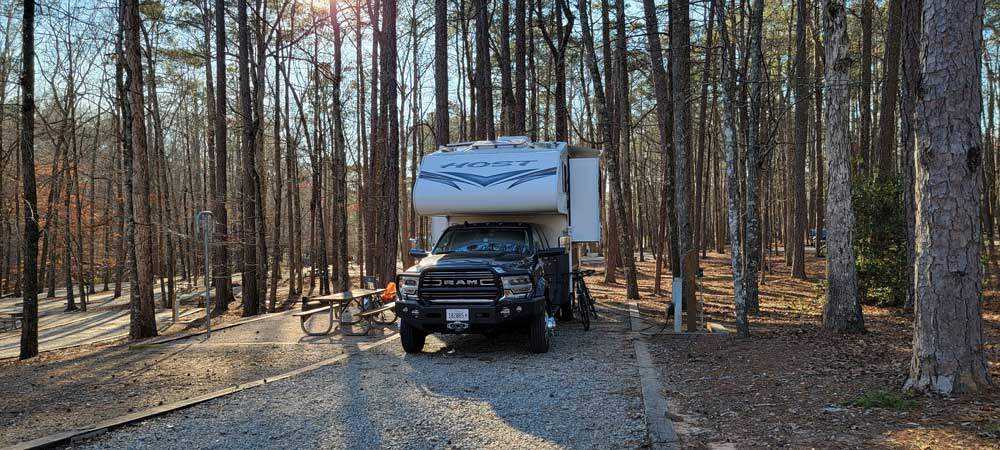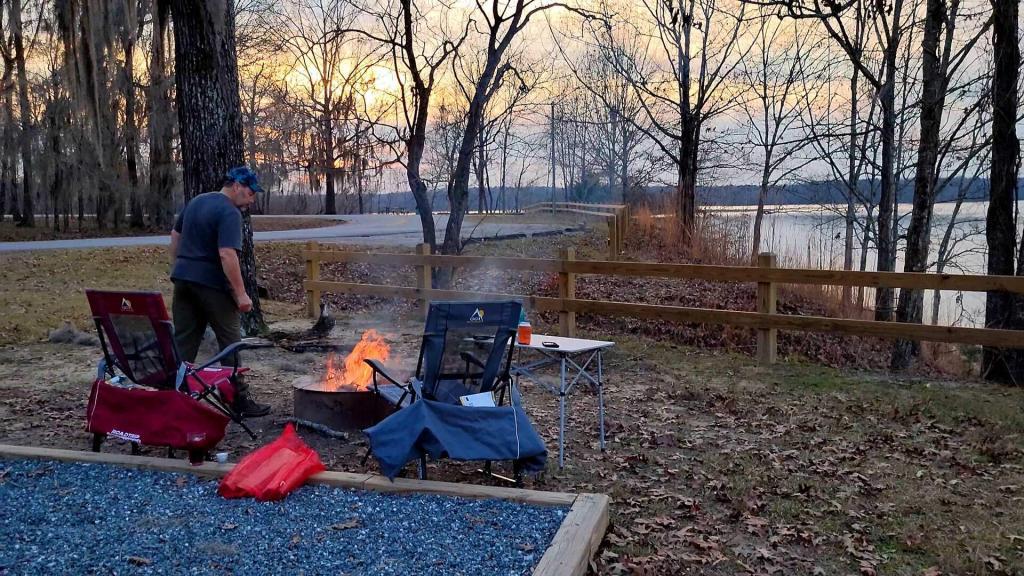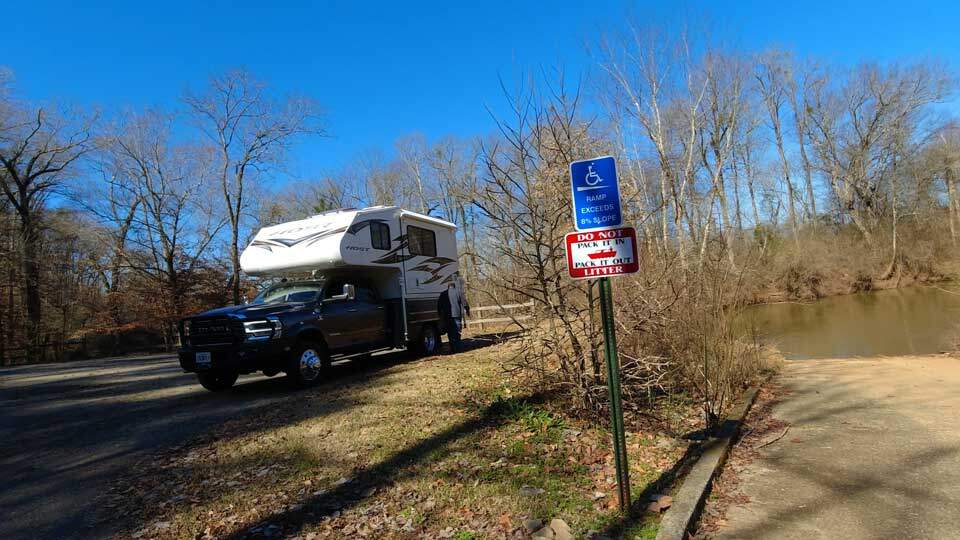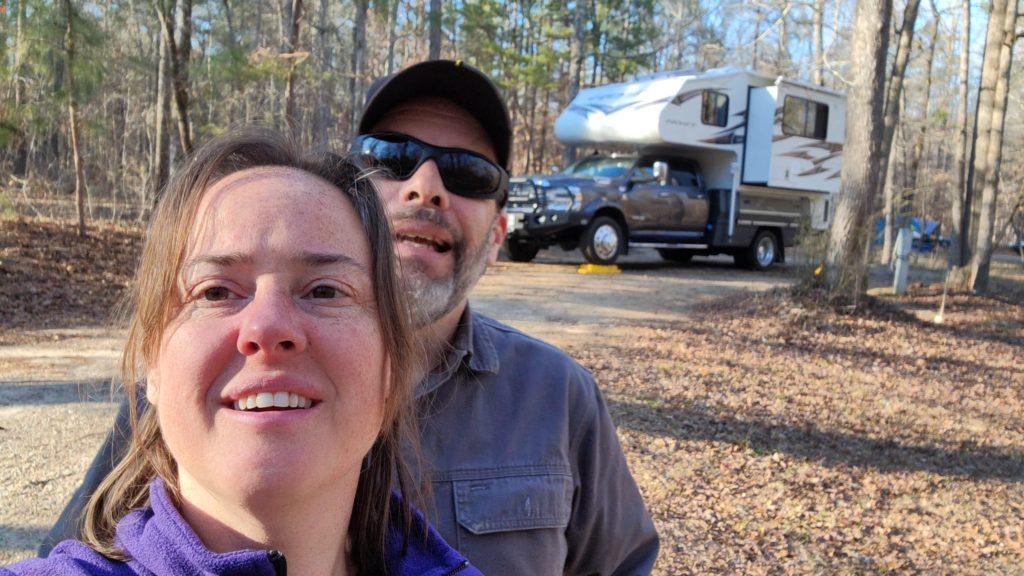We are slowly figuring out that finding great campsites is part searching and part artform. This go-round we ended up finding sites that really didn’t fit our plan. Are they BAD? Not really. Campsites are as varied as RVs! But for us, we chose poorly.
What went wrong?
Well, after mulling on this while making the above video, I realized that perhaps we had too many criteria for one campsite to meet and we never really prioritized items first.
Our ideal campground/campsite would have:
- Decent-size sites (so you don’t feel like cordwood)
- Fairly easy to level RV
- Access to hiking or biking trails
- Access to kayaking opportunities
- Either electric hookups or sites open to sunlight for solar panel charging
- Access to water and dump options at the campground
- Minimal traffic noise (we don’t want to feel like we’re in town)
- Within 45 minutes to get food, gas, propane, laundry, etc.
- Less than $20 a night
After typing that all out, it’s obvious to realize that we’re suffering from a problem of unrealistic expectations. We had a few locations we were looking at that met most of the above criteria but were higher in cost than we wanted. We forgot to recognize that there really are tiers to get to the above goals.
State or Federal Parks (or COE Parks, etc.)
In general, you’ll be able to meet most of the above at state or federal parks. The size of sites would be pretty dependent on the location, but you have a decent chance. On most occasions, though, you’re not going to be able to meet that $20 bogie!

County Parks (Or Forest Service Areas, BLM areas, etc.)
The county parks that we’ve stayed at have generally been under that $20 a night but you may have to drive a bit more to get to hiking or biking trails. Kayaking would be as unlikely as having any hookups (electric, water, dump stations). The noise could be from nothing to major interstate noise.

County parks will also likely not have anyone on-site on a regular basis so in our situation, we would need to keep the camper on our truck (to avoid an opportunity for grabby-hand syndrome).
Oconee River Campground
So, if you took our crazy list from above and applied it here, this is what we get. If we could have kayaked there, we may have tried to get level again in the morning. But ultimately there wasn’t a lot to keep us occupied with our time there. Even fishing would have been challenging. We were also hoping to try and find a site where our solar could help us out (generators could not be run here) but that was a no-go as well.
Available
- Decent-size sites
- with 45 minutes to get food, gas, propane, laundry, etc.
- less than $20
Not Available
- Fairly easy to level RV
- Access to hiking or biking trails
- Access to kayaking opportunities
- electric hookups / sunlight for solar
- access to water/dump options
- minimal traffic noise

Lake Sinclair
So let’s continue this exercise for Lake Sinclair Recreation area. There was a lot more in the available category but it simply came down to little to do in the area. We didn’t realize the lake would have so many houses and the water was quite murky (maybe from some of the recent rains). So we decided kayaking was out.
One thing that was not on the original list was comfort-level of a campground. We honestly were not sure if the RVs there were the camp hosts or just have been there for a very long time. And the campground was definitely not kept up. It didn’t give us a “lets leave now” vibe but it did give us a “let’s find another place tomorrow” vibe. Again, just our experience – YMMV.
Available
- Decent-size sites
- with 45 minutes to get food, gas, propane, laundry, etc.
- electric hookups / sunlight for solar
- less than $20
- access to water/dump options
- minimal traffic noise
Not Available
- Fairly easy to level RV
- Access to hiking or biking trails
- Access to kayaking opportunities

So what’s the Lesson?
Honestly, there’s no right answer. We’re slowly learning that probably alternating between state/federal parks and county parks is likely our best balance – we may have more active weeks at a State Park where there’s a lot to do. The next week we may have more down-time at a county park to help catch up on chores and videos/website stuff (I’m still struggling with calling this work) while keeping monthly campsite fees in check.
And this is pretty doable if we plan to alternate – make sure everything’s ready to be off-grid for a week or so before you leave that state park.
Still more to Learn?
Yeah. I’m still not sure what to do when we’re at a county park or Forest service area that is dry camping but does not allow generator usage. We’ve run into that a few times here in Georgia and I think it’s related to the fact that the land may be close to residential areas (their forest lands and private property are heavily checker-boarded). Staying at a place like this that has heavy tree cover but you’re not allowed to use your generator is difficult especially if you’re staying more than 2-3 days.
We got around that at River Bend Park by driving to multiple destinations which allowed us to use our truck alternator to charge while on the road. We could use the truck to charge the house batteries but it seems like it would be just as loud as the alternator.
And driving around is a costly endeavor these days with diesel hitting close to $4 a gallon. Propane isn’t the cheapest either. Oh so much to think about….
Camping Locations
If you’re interested in seeing all of the places we’ve stayed in 2022, I’m keeping a (mostly) updated list on Google Maps by Month. Enjoy!
Leave a Reply
You must be logged in to post a comment.